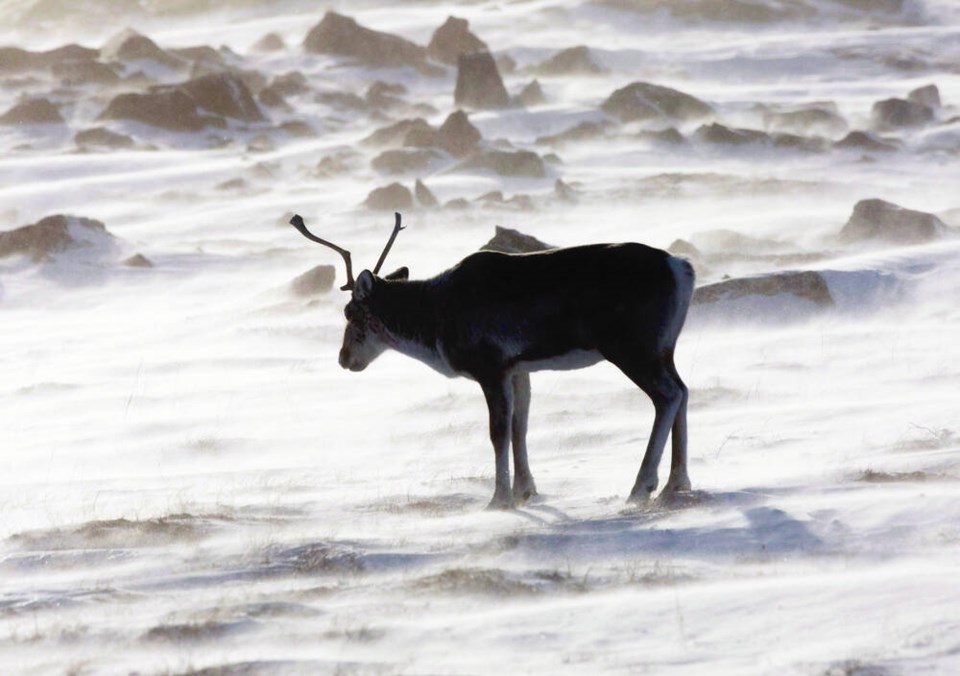Tonight, kids will be nestled all snug in their beds, dodging visions of dancing sugar-plums in their heads and awaiting the sound of prancing and pawing little hooves on the rooves.
And while the youngsters are anticipating midnight visits from a jolly ol’ elf reining in eight tiny reindeer, let’s take a moment to consider the air-borne ungulates.
The reindeer said to pull Santa’s sleigh are likely domesticated European reindeer. The same species lives here in North America, where we call them caribou.
Whether living in Europe’s or North America’s Arctic or in B.C.’s or Alberta’s mountains, caribou are specially adapted to survive some of the world’s coldest, snowiest and darkest winter conditions.
Like polar bears, caribou have thick coats made of hollow hairs that trap heat close to their bodies like a big, puffy jacket.
Their platter-like concave hooves act as small snowshoes to help the animals move quickly over and through wintery terrain. The feet also serve as snow shovels as needed to dig out food from under the snow.
With snow blanketing the landscape and few grasses or leaves growing for two-thirds of the year, lichen is one of the few food sources widely available across the tundra during the winter.
Caribou take full advantage of the lichen abundance. They eat the equivalent of about two garbage bags full daily of lichens during the winter.
Their super-efficient digestive system makes it worthwhile, absorbing all the nutrients to be found in the barely digestible fungi–algae life forms.
Similar to cows and horses, caribou are ruminants. They chew cud — mouthfuls of partially digested, semi-fermented, regurgitated lichen. In polite circles, which in our household doesn’t usually include family Christmas dinners, cud chewing is called ruminating.
Not only is their digestive tract set up to deal with copious quantities of tough and acidic lichen, caribou are able to smell lichens through the snow.
They also have special lichen-spotting vision.
As part of this, caribou are one of the few species whose eyes change colour with the seasons. In summer, caribou eyes are golden. In winter, they become bright blue.
Blue eyes allow more ultraviolet light to pass through to the eye’s colour receptors.
In 2011, British researchers determined that caribou see extremely short wavelengths of light between 350 and 320 nanometres, well into the ultraviolet spectrum. (Humans can see ultraviolet light down to only about 400 nm.)
Ol’-blue-eyed caribou indeed dream of white Christmases. Their special UV vision means they see the winter world in shades of purple, similar to how a person sees a room with a black light.
And just as a white T-shirt that has been washed with phosphorous-containing laundry detergent reflects UV and glows bright under black light, UV-reflecting snow would appear as beacons of brightness to caribou eyes.
But some things that are very important to caribou — for example, urine and fur — absorb UV light. These signs of nearby predators or competitors appear as pools of black to caribou eyes.
Lichen, which is really important to caribou, also absorbs UV light. According to a study published this month in the journal i-Perception, spectral data from the lichen and light filters designed to mimic reindeer vision show that reindeer see lichens as dark patches against an otherwise brilliantly snow-glowy landscape, making the lichens easier to locate.
Arctic reindeer also have a special ability to multitask. European researchers reported in the journal Current Biology this week that reindeer can sleep deeply while chewing their cud. Recordings of reindeer brainwaves during rumination resemble the brainwaves present during deep, non-dreaming sleep. The brainwave patterns suggest the reindeer are more “rested” after ruminating.
Not many creatures can sleep while they eat, but this particular ability might help reindeer get enough sleep during the summer months, when food is abundant and reindeer feed almost around the clock to prepare for the long and food-sparse Arctic winter.
A winter that includes one night of supersonic air travel to rooftops around the world.
Maybe on some of those rooftops, the prancing and pawing platter-hoofed reindeer will find some lichens to snack on while Santa feasts on sugar-plums and cookies down the chimneys.
Happy holidays to you and yours!


